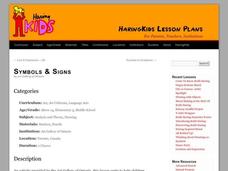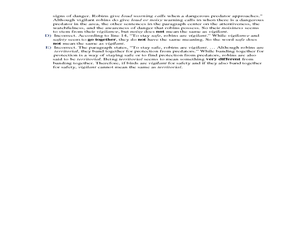Curated OER
ASL Lesson 4
Provide your hearing-impaired or special-needs learners with a functional ASL vocabulary focused on feelings and family. Lesson 4 in this extensive series allows you to view both images and videos of each word or sentence as it is...
Curated OER
How to Speak Without a Voice
Some babies are learning sign language before learning to speak. Given the scenarios in this quiz, can you identify what each sign means? Multiple-choice answers are provided for each question. Use this resource in a psychology or sign...
Curated OER
The Human Brain's Capacity for Language
Incorporate this slide show into your lecture about speech, language, psychology, or physiology. Addressing the structure of the brain as well as handedness and aphasia, the presentation could fit the needs of many different lecturers....
Curated OER
Figurative Language: Simile and Metaphor
What is figurative language? Introduce your young learners to the most popular forms of figurative language: the simile and the metaphor. Start by reading "Willow and Ginkgo" by Eve Merriam, and identify where similes are used. Then look...
Curated OER
"Some Excellent Dumb Discourse:" Caliban as native American
Explore The Tempest and how language and power are intertwined in the play. Through a series of questions (provided) and an intense activity that has groups translate Caliban's speech into American Sign Language, learners recognize...
Curated OER
Sign Language 1
Third graders explore signs and vocabulary linked to the work of Keith Haring.
Curated OER
Simile Practice
Inspire creative writing by studying similes. This sheet provides learners with 10 different topics, and they must create a simile for each topic. Example topics include: favorite teacher, the waterfall, a parrot, the first day of...
Curated OER
Farm Babies
Students use flash cards to match the mother names to the baby names for farm animals. In a designated "barn" in the room, students simulate being mothers, fathers, and babies. The baby must find his mother and father. Students visit...
Curated OER
Don't Burn, Baby, Burn!
Learners consider products that provide protection from sunburn and other negative effects of the sun's ultraviolet rays. They develop or improve upon sun-screening products that are meant to provide protection for populations at risk...
Curated OER
Babies At Play
In this babies at play learning exercise, learners practice viewing a picture of babies playing in the Fall and color the picture with vibrant colors.
Curated OER
Whose Point of View? The Journey of Three Generations
A reading of Whale Journey, a fact-filled picture book by Vivian French, launches a study of the life cycle and migration of three generations of gray whales. The interdisciplinary lesson offers opportunities extensions into all subject...
Curated OER
Clapping the Number of Syllables in a Word - School/Home Links
In this word work worksheet, students work with a learning partner to determine the number of syllables in six words that are read to them. They clap once for each syllable they hear. There is a place for both the student and learning...
Curated OER
Symbols and Signs
Students draw lines and symbols to express emotions much like the work of Keith Haring. In this drawing lesson plan, students use markers, boards, newsprint, scissors, and more.
Worksheet Web
Burrowing Animals – Ground Squirrels
Why do ground squirrels build their homes in the ground? What's so unique about these burrows? Have individuals read about this burrowing animal, and then respond to five short answer questions that assess their comprehension of the...
Curated OER
Britney Spears: Famous People, ELL Assignment
If you teach English learners and want a thorough assignment that addresses reading and listening comprehension, speaking skills, vocabulary acquisition, and more, a high-interest content worksheet on Britney Spears may be useful. It...
Curated OER
The First Part Last: Part 4
In this The First Part Last comprehension check worksheet, students respond to 34 short answer questions pertaining to part 4 of the Angela Johnson novel to better understand the novel and the author's craft.
Curated OER
Comprehension Questions: The City of Ember, Chapter 20
Comprehension questions for the last chapter of Jeanne DuPrau's book The City of Ember assess factual recall, sequencing skills, and inference about the text. Note: One question about point of view is based on a sentence not related to...
Curated OER
Ambiguous Statements
Discuss the dangers of ambiguous statements using this presentation. There are a list of often funny statements, such as I saw her duck. Learners will love talking about these statements and coming up with their own.
Curated OER
The Learning Network: The First Middle School Chess Champs
Introduce some nonfiction reading into your classroom! This resource contains seven comprehension questions pertaining to an article from The New York Times website about the first middle schoolers to ever win the United States Chess...
Curated OER
The Cat Ate My Apple
Students recognize the phoneme for the short vowel a in written and spoken language. Through a variety of activities, they discriminate the short vowel /a/ from other phonemes. Students associate the phoneme with its letter...
Curated OER
English Vocabulary Skills: AWL Sublist 8 - Exercise 1b
In this online interactive English vocabulary skills worksheet, students answer 10 matching questions which require them to fill in the blanks in 10 sentences. Students may submit their answers to be scored.
Curated OER
Letters from the Japanese American Internment
Students delve into primary research. In this Japanese Internment lesson plan, students make deductions about life in an internment camp by reading and comparing letters written to Clara Breed. Along the way, they consider the advantages...
Curated OER
Vocabulary Review
In this vocabulary review worksheet, learners choose all words that logically complete the sentences. Students complete eight sentences.
Curated OER
Intermediate Critical Reading - The Robin
In these critical reading worksheets, students read the short story about robins. Students then answer 3 critical reading questions about the passage.

























